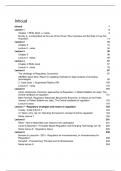Summary
Summary REAL COURSE lecture 1-11 summarized + course notes
- Course
- Institution
This documents includes ALL the literature of lectures 1-11 that was mandatory for the REAL course in september 2023 and includes some notes on the lectures as well. Could be useful as a tool as well when you need to look up some information on a topic :) This course is part of the LLM Law and ...
[Show more]



